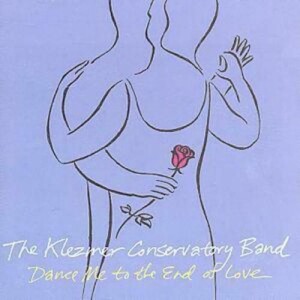 Brendan Foreman wrote this review.
Brendan Foreman wrote this review.
If one would consider the KlezRoym New School, then the Klezmer Conservatory Band is thoroughly Old School in their approach to the music. All of the usual forms of klezmer are here: the frenetic freylekhs, the mysterious horas, melancholy waltzes. But rather than coming across as a group of stuffy scholars with the goal of sounding like their great-great-grandparents did, the Klezmer Conservatory Band is seeking to preserve the vitality and spark of old-time klezmer while expanding the repertory of klezmer as a musical form. After all, the title track is in fact a rather sultry love song written by Leonard Cohen.
This is actually the ninth release by KCB, and the year 2000 marks their twentieth year in existence. As with a lot of good klezmer bands, KCB is a large ensemble with Judy Bressler singing the leads; Ilene Stahl on clarinet; Deborah Strauss on violin; Robin Miller on flute; a substantial horn section consisting of Mark Berney, Mark Hamilton, and Hankus Netsky; Jeff Warschauer on mandolin and guitars; Art Bailey on piano; James Guttman on bass; and Grant Smith on percussion. The music of KCB bears this out with a full ensemble sound and plenty of soloing.
The freylekh is essentially klezmer’s version of the polka. Usually fast and even frenetic in spirit, it is a thoroughly fun dance form that showcases any klezmer band’s need for speed as well as improvisational skills. Here the Conservatory members show themselves easily among the best from the traditional “Taxim,” which is almost completely improvised to the medley “Di Mekhutonim Geyen/Tants a Freylekhs (The In-laws Are Coming/Dance a Freylekhs).”
These songs are often accompanied by lyrics that are as ribald as an Isaac Bashevis Singer story. The message behind the Catskill-era “Freylekh Zayn (Be Happy)” seems to be “Be happy because, no matter what you do, your spouse is going to cheat on you.” On this song, the lead singer Judy Bressler gets an excellent chance to do some improvisation of her own. In fact, while listening to these tracks, it is hard not to imagine that the early Jazz players of the 20th century might have been a little influenced by the highly Jewish presence of Tin Pan Alley at the time.
Another prominent form is the hora. This is an intense circle dance that always starts slows and builds up in tempo. It is a real pleasure to see live and danced to. Here mandolinist Jeff Warshauer gets the spotlight with a medley of beautiful horas called simply “Hora/Moskowitz Medley.”
This all is just scratching the surface of the variety of music here. There are the lullaby “Schlaf in Zisn Ru (Sleep in Sweet Repose)”; “Bublitchki (Bulkie Rolls),” an old Russian ballad turned into early ’50s-style orchestral swing, complete with a rather seedy sounding lounge piano part; and “Der Terk in America (The Turk in America),” which is a klezmer treatment of a Greco-Turkish melody. With its syncopated rhythm and strident drumming, this last track would not sound out of place among the Thracian Rom music of Selim Sesler.
Anyone with even a modicum of interest in klezmer music will find much to enjoy on this CD. With this release, the Klezmer Conservatory Band proves itself to sit among the current favorites such as the Klezmatics as well as among the “greats” like the Klezmorim.
(Rounder, 2000)
